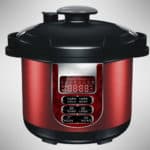To many, Sushi is just a bit of rice, some raw tuna, or fish. However, there are actually lots of different types of sushi.
View in gallery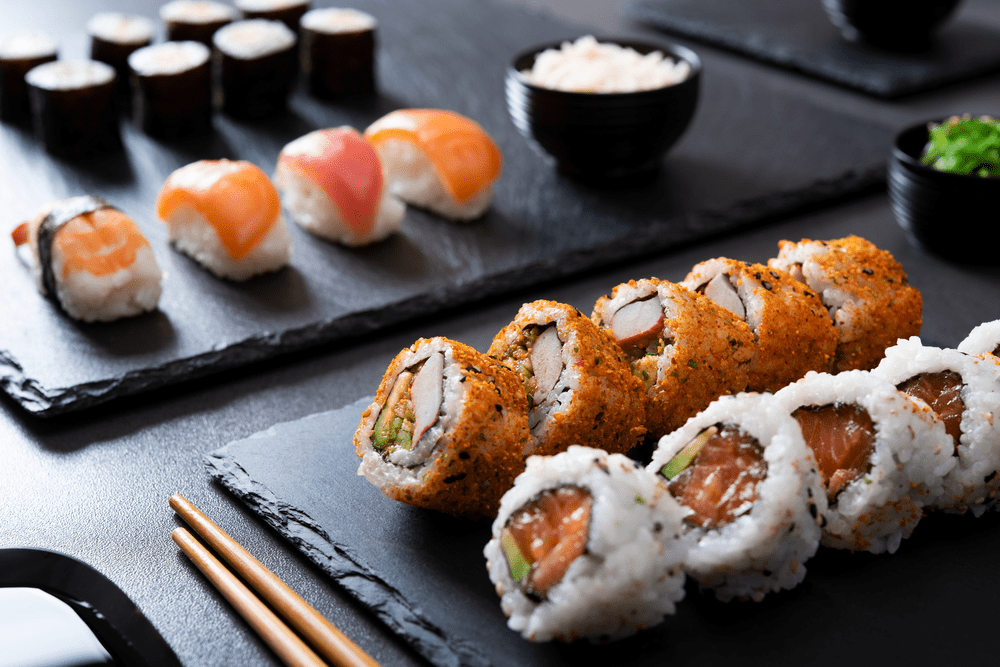
Whether you’re visiting the sushi mothership that is Japan or picking up a tray from your local supermarket, it is essential to know your chirashi from your maki and your nigiri from your sashimi.
For those new to the sushi world, or if you’re just confused by the differentiating factors, we’ve covered the nine main types of sushi so you can be an expert when ordering your next sushi roll, plate, bowl, or cone. Don’t worry; we’ll get into all the specifics!
Sushi is More Than Just Raw Fish?
When you think of sushi, your mind probably wanders to rice neatly rolled up in a thin layer of seaweed. Now, you’re not wrong. There is a type of sushi that is rice neatly rolled up in seaweed. But, there are also eight other main serving types that we categorize under the term “sushi.”
View in gallery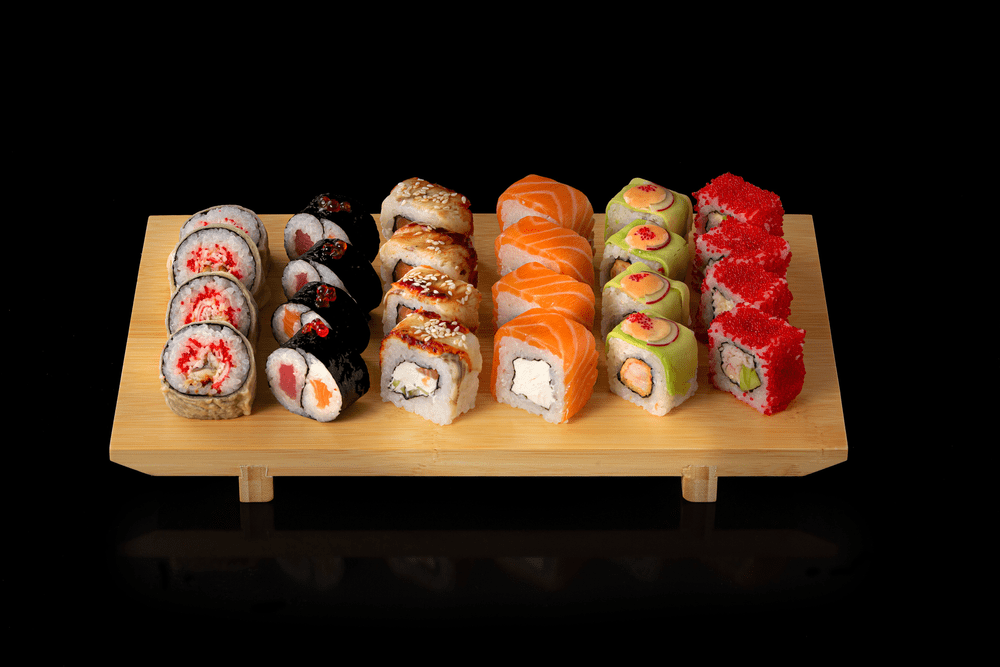
Before we get into the different sushi types, let’s first discuss what exactly sushi is. Sushi originated in Japan and has since spread to supermarkets and restaurants worldwide.
The creation of sushi is said to be highly skilled and artistic. If you’ve ever tried to make your own sushi, you’ll understand the level of skill needed to make even basic sushi rolls.
Sushi typically uses a combination of raw and cooked fish and special sushi rice and vegetables. Itamae (sushi chefs) have also adapted the recipes to include different meats for all the non-fish lovers out there.
Regardless of the fillings or toppings, sushi always contains specially prepared vinegared rice.
Sushi is commonly accompanied by small side garnishes. These garnishes include soy sauce, pickled ginger, and the distinctive green spicy wasabi.
The 9 Main Types of Sushi
Now that we’ve covered the basics of what sushi is, let’s get into the nine main types of sushi and how they differentiate from one another.
1. Chirashi
View in gallery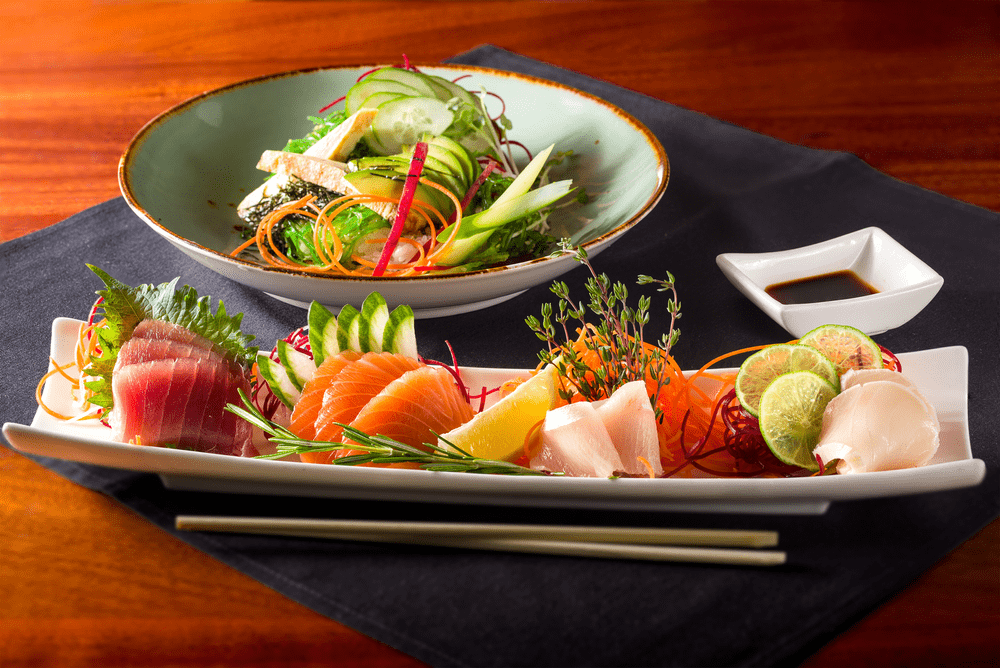
As we mentioned before, when you think of sushi, a seaweed-covered rice roll comes to mind. Well, dishes like chirashi also fall under the sushi category. The Japanese word chirashi means “scattered,” and the dish perfectly represents the word.
Chirashi sushi is a bowl of vinegared rice, usually topped with raw or sometimes cooked fish. Itamaes also add vegetables and mushrooms to the chirashi sushi bowl. Along with fish eggs depending on the customers’ desires.
Seafood donburi regularly gets confused with chirashi sushi. Although they’re structured and look fairly identical, the difference comes down to the rice. Chirashi uses typical vinegared sushi rice, whereas donburi uses a bowl of unseasoned rice.
2. Gunkan
View in gallery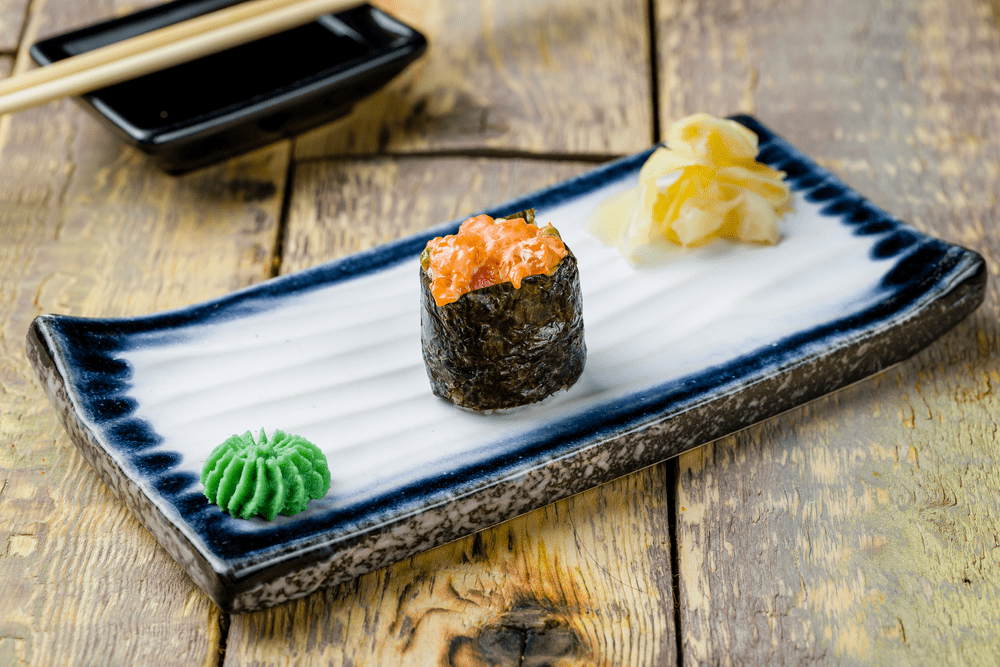
The Japanese word gunkan translates to warship or battleship. In some senses, gunkan sushi is precisely that.
Gunkan is an oval-shaped nori seaweed pouch filled with rice and topped with roe. Roe is fully developed raw fish eggs that chefs add on top of sushi. Flying fish roe, salmon roe, or sea urchin roe are some of the most common roe chefs add to gunkan.
Chopsticks are the favored tool for eating gunkan. If it’s your first time enjoying this type of sushi, it is unnecessary to dip it into a sauce. The roe on top of the gunkan sushi is adequately flavored and enough on its own.
3. Inari
View in gallery
Inari is a type of sushi suitable for vegans, as it consists of sushi rice, and tofu. Chefs create a pocket of tofu and fill it with characteristic vinegared rice.
As inari sushi only has two ingredients, it is relatively inexpensive compared to other types of sushi.
4. Maki
View in gallery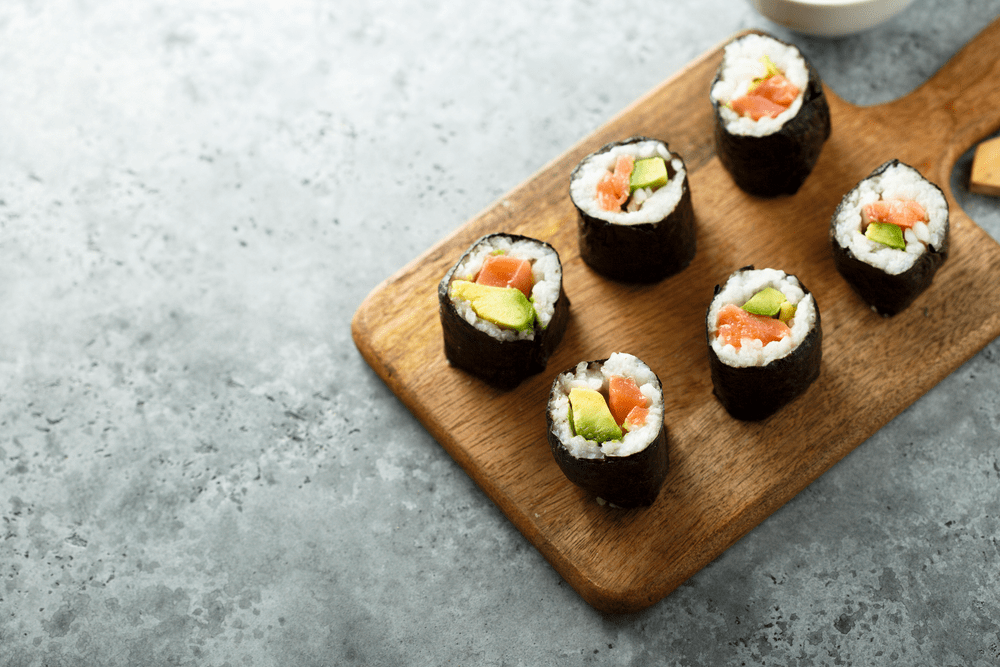
Maki Sushi is quite possibly the most common type of sushi eaten by people worldwide. You may also know it as a “sushi roll.” You can find this type of sushi in restaurants and supermarkets, as it is one of the easiest to eat.
To make a Maki roll, itamaes take a sheet of edible seaweed, also known as nori. On top of the nori, they layer sushi rice with a selection of fish, vegetables, or meat. Once they tightly roll the maki, they cut it into bite-sized pieces.
You can also make maki in a thin slice, known as hosomaki, or a thicker version, futomaki.
5. Nigiri
View in gallery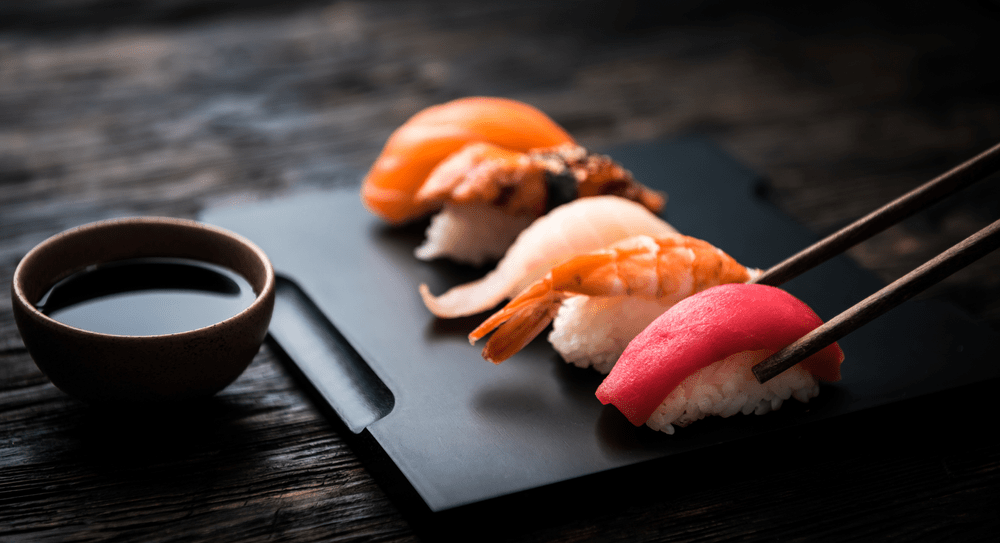
Nigiri sushi is an oval-shaped mound of vinegared rice with a slice of seafood on top. Most of the fish variants that are used on nigiri sushi are uncooked. Shrimp or eel nigiri, however, is cooked, and if you’re lucky enough to see the sushi being made in sushi restaurants, you’ll see itamaes cooking the fish with a blowtorch.
Sushi chefs mold the sushi rice by hand, topping and slightly pressing the raw fish on top. Because sushi rice is stickier than your average rice, it helps to keep the nigiri in perfect shape. Some of the most common fish with which chefs create nigiri sushi are raw tuna, salmon, and halibut.
In Japan, they traditionally eat nigiri by hand and not with chopsticks. When dipping the nirigi into soy sauce, the Japanese flip the nigiri, so the fish side of the sushi enters the sauce and not the rice.
The Japanese see staining the rice with soy sauce as a minor taboo. Dipping the rice side of the nigiri into the sauce can crumble the sushi. And crumbled sushi is far more challenging to eat.
6. Oshizushi
View in gallery
Oshizushi are types of sushi that sushi chefs press into a special mold. The mold, known as oshibako, forms the sushi into perfect rectangular shapes.
This pressed sushi, much like the other sushi types, has a base layer of sushi rice that is topped with a range of different raw fish.
7. Sashimi
View in gallery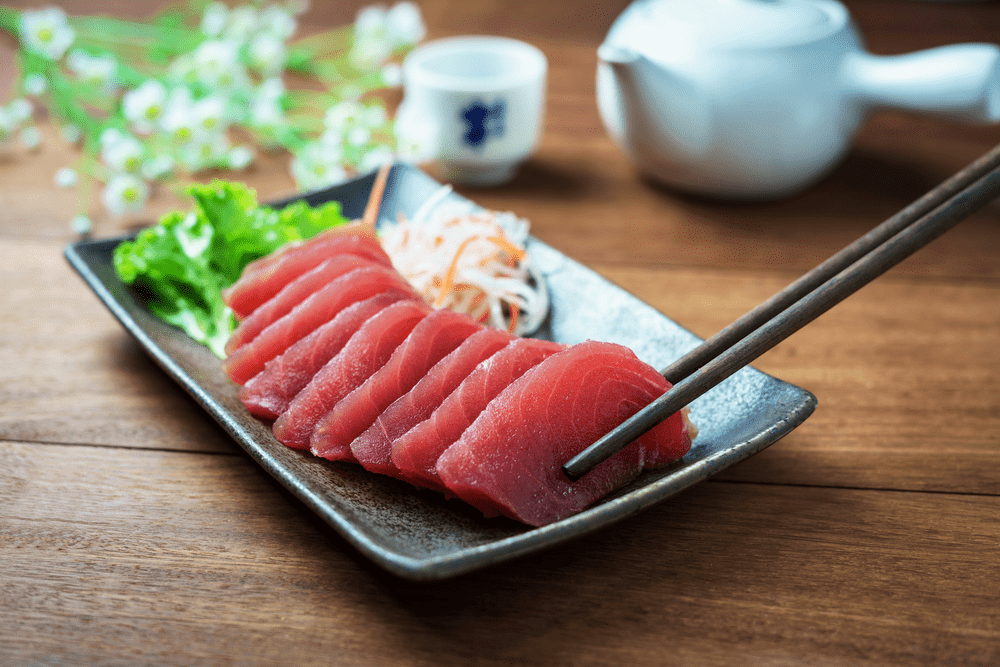
Although sashimi has made it onto the list, it isn’t technically a type of sushi. Sashimi is essentially a slice of raw fish seasoned with soy sauce, miso, ginger, or wasabi. As we mentioned before, to be classed as sushi, it needs to contain the special vinegared sushi rice.
With that being said, we thought it was important to mention, as it is a popular dish served in a sushi restaurant.
The long slices of raw fish are known as hira-zukuri. And some of the common fish used in sashimi are tuna, salmon, and mackerel.
8. Temaki
View in gallery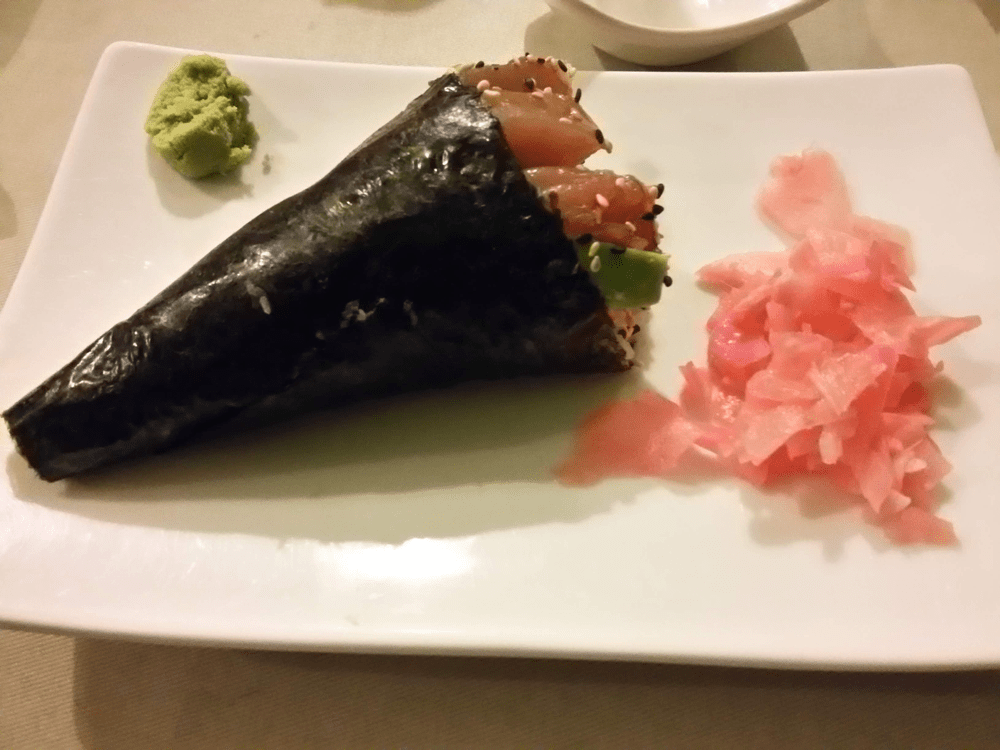
If you regularly eat sushi, you may already know about temaki. Temakis are a type of hand-rolled sushi that are slightly similar to traditional maki. Itamaes roll maki into tight cylinder shapes. But with temakis, they loosely wrap the fillings into ice cream cone-like shapes.
Temakis range in size from thin, lightly packed cones to thick cones jam-packed with ingredients.
9. Uramaki
View in gallery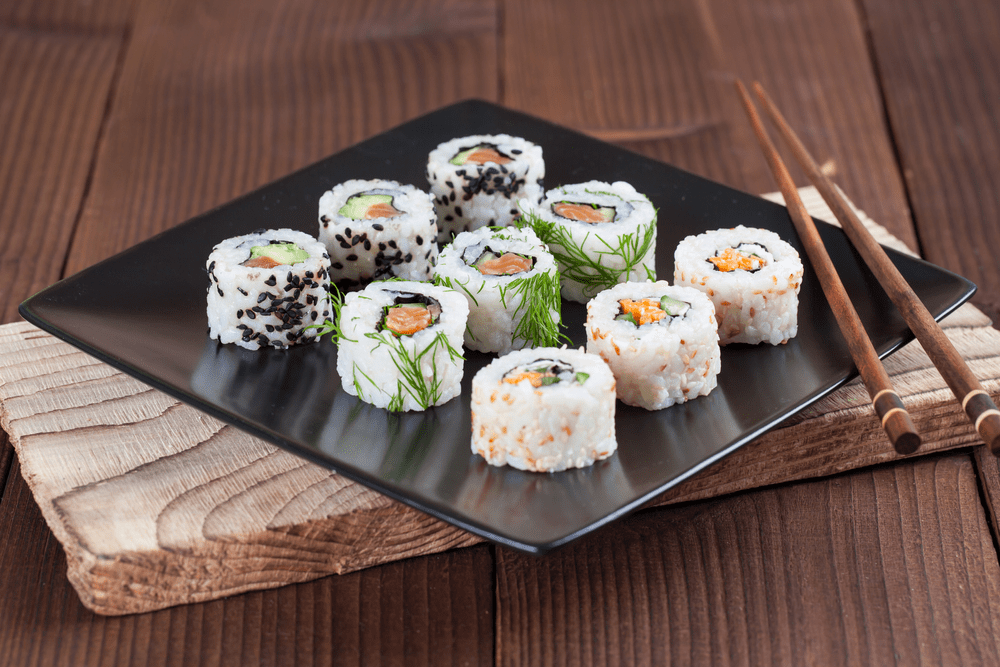
An uramaki is an inside-out roll with its rice layer on the outside. So it’s pretty much an inside-out maki. Fillings on the inside, a layer of nori, and then an outer rice layer.
Like its maki cousin, itamaes cut uramaki into bite-sized rolls. Uramaki, however, is usually slightly thicker than traditional maki.
Sushi chefs top uramaki with a selection of toppings such as sesame seed, kewpie mayo, and fish eggs.
11 Types of Sushi Rolls
It’s without a doubt that sushi rolls are the most common type of sushi eaten all over the world. Sushi restaurants to supermarkets stock a variety of sushi rolls, from basic vegetable rolls to beautifully crafted rainbow rolls.
Here are some of the most popular sushi rolls that you should try on your next sushi outing.
1. Alaska Roll
View in gallery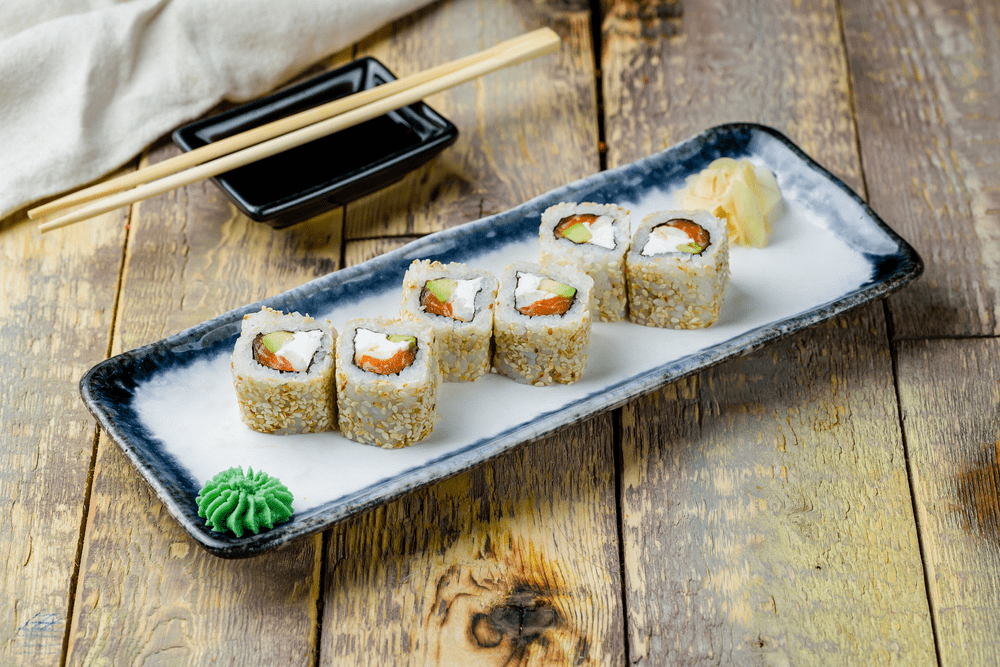
Alaska is home to numerous salmon species. So, it seems only fitting that we should name a salmon topped sushi after the US state.
Itamaes construct Alaska rolls as uramaki types of sushi. They wrap the nori around the contents of smoked salmon, cucumber, and avocado.
Finally, they finish it off with a layer of sushi rice. Sushi chefs occasionally add asparagus to Alaska sushi rolls, depending on the consumer’s particular tastes.
2. Boston Roll
View in gallery
Shrimp is a firm favorite in the sushi community, and that’s what makes the Boston sushi roll extremely popular.
Sushi chefs use the uramaki sushi method with Boston rolls as well. They wrap poached shrimp and avocado in a nori seaweed sheet.
Like typical uramaki, the seaweed is further wrapped in sushi rice. To then give the sushi roll some added flavor, itamaes then coat the rice in tobiko (flying fish roe).
3. California Roll
View in gallery
If you’ve ever even looked at a sushi menu, then you would have seen the option of a California roll. The California roll is one of the most popular sushi rolls out there because of its textures and rich flavor.
Again, using the uramaki method, sushi chefs wrap imitation crab meat, cucumber, and avocado in nori. They finally roll it up in sushi rice and top it with either sesame seed or roe.
4. Cucumber Roll
View in gallery
Basic but a classic. You really can’t go wrong with a cucumber roll. No matter your food preferences, everyone can eat a cucumber sushi roll (unless you’re allergic).
Thin cucumber sticks make up the sushi rolls filling. Itamaes then wrap it in the maki method. First with rice, and then with nori seaweed. Simple, but oh so satisfying.
5. Dragon Roll
View in gallery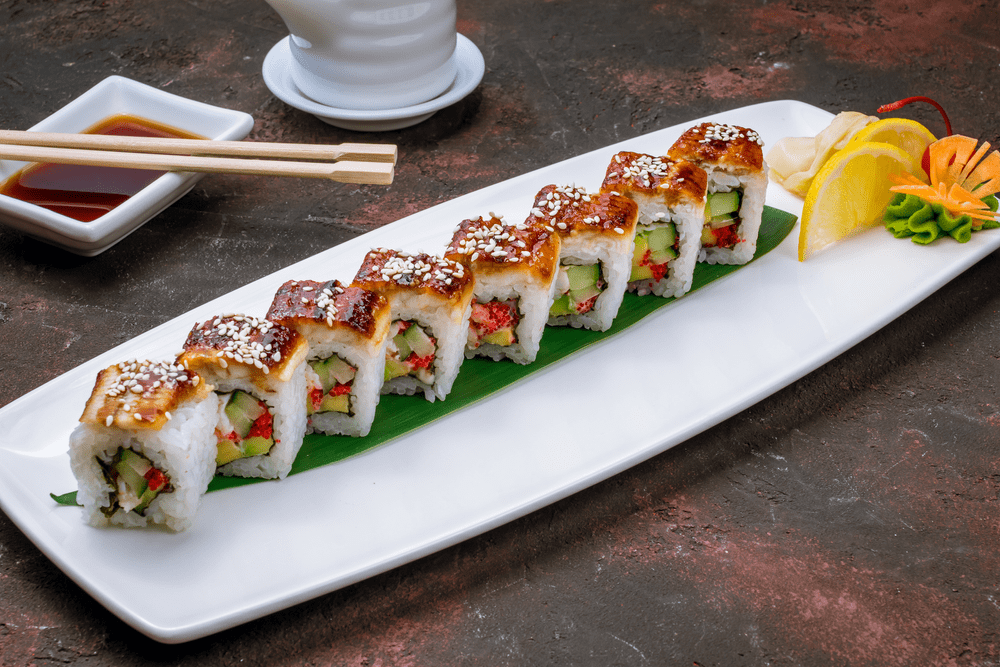
If you’re new to the sushi world, this one may be slightly out of your comfort zone. But dragon rolls conjure up a mixture of unique tastes that pair together perfectly for those willing to try.
The uramaki sushi roll contains cucumber, avocado, and unagi (eel). You may also know them as a caterpillar roll due to their avocado topping designed to look like the scales of a dragon. Sushi chefs will also dress the dragon roll with unagi sauce and toasted black sesame seeds.
6. King Crab Roll
View in gallery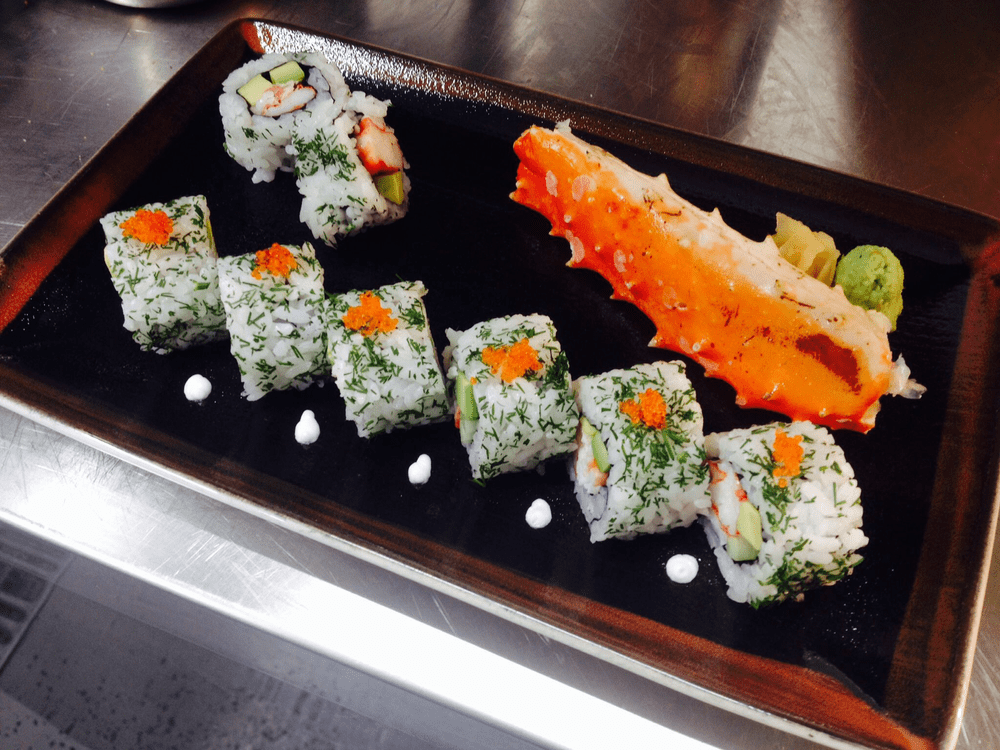
The king crab sushi rolls filling is king crabmeat, mayonnaise, and avocado. Similar to that of a California roll; however, itamaes use real king crab meat in king crab rolls. To finish, they use sesame seeds and occasionally spicy mayonnaise to give the roll an extra kick.
7. Philadelphia Roll
View in gallery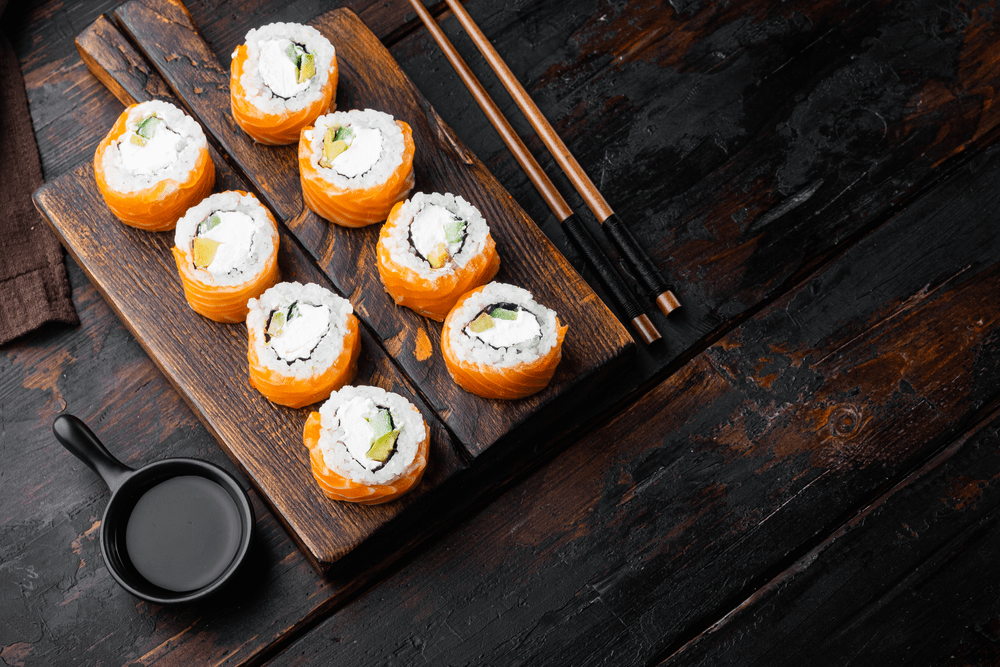
Do sushi and cream cheese go together? Ultimately, that’s up to you to decide, but many opt in favor of the pairing.
Philadelphia sushi rolls are stuffed with salmon, avocado, and, of course, Philadelphia cream cheese. Once sushi chefs wrap the uramaki-style roll, they finish it with a sesame seed topping.
Cream cheese and salmon don’t just go well together in sushi. If you like the pairing, why not try it in other dishes too?
8. Rainbow Roll
View in gallery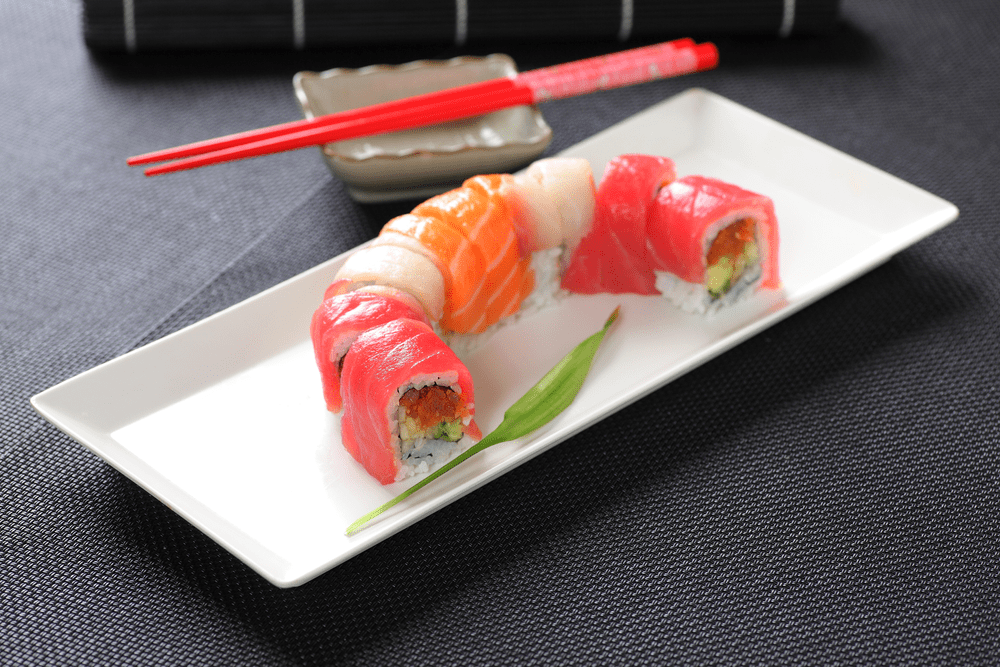
Quite possibly the most beautiful types of sushi rolls are rainbow rolls. Even their name gives away how aesthetically pleasing these rolls are.
The basis of a rainbow roll is the same ingredients chefs use in California sushi rolls. Imitation crab meat, cucumber, and avocado.
What makes a rainbow roll different is the fresh fish variants that layer the outside of the roll. Sushi chefs use tuna, salmon, whitefish, and yellowtail to create Instagram-worthy sushi designs.
9. Spicy Tuna Roll
View in gallery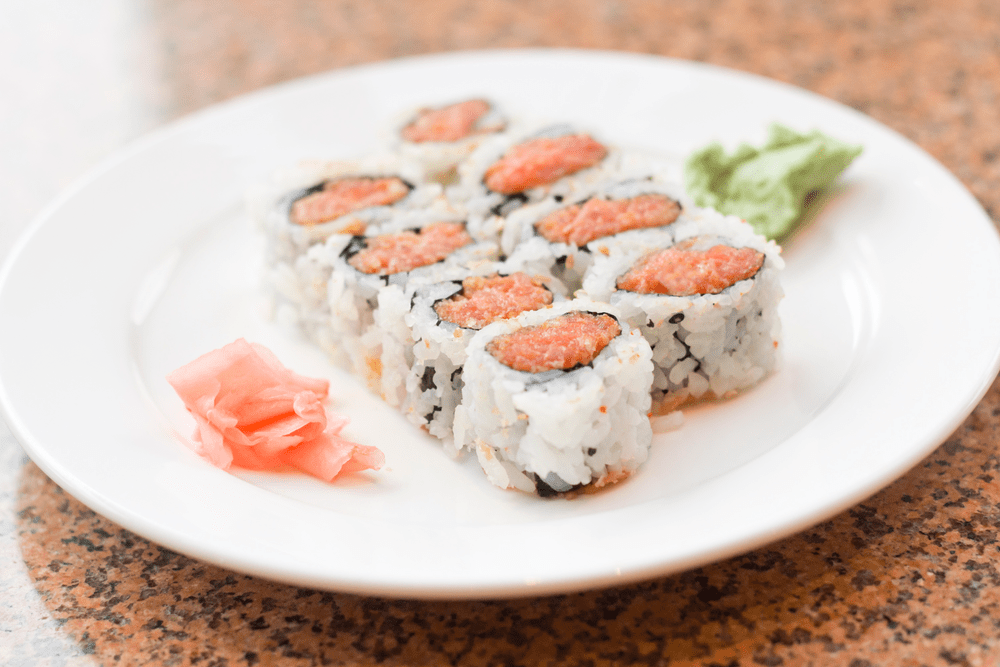
If you prefer a slight kick to your sushi rolls, the spicy tuna roll may be for you. Itamaes form spicy tuna rolls using either the maki or uramaki method.
Spicy tuna rolls can simply consist of tuna and spicy mayonnaise, or itamaes can roll them with avocado inside. Sesame seeds and extra spicy mayo are also popular garnishings for these types of sushi rolls.
10. Spider Roll
View in gallery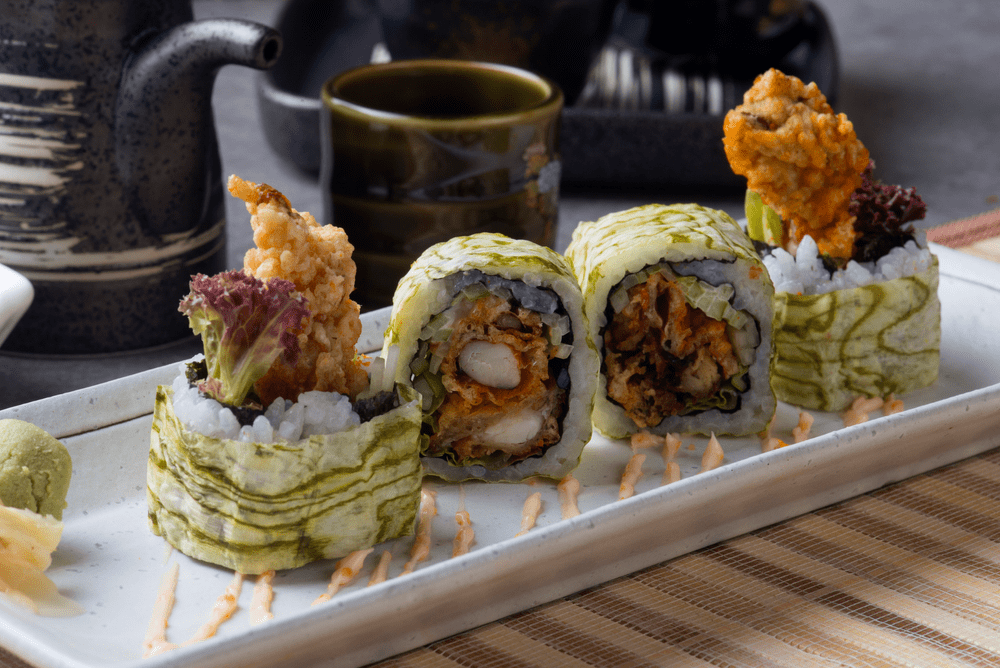
Presentation is key when it comes to this one. If you’ve ever seen a spider roll, you’ll know what we’re talking about.
The contents of a spider roll are similar to a king crab roll or California roll. But, a spider roll has a tempura soft-shell crab filling. Avocado, cucumber, and spicy mayo accompany the soft-shell crab.
But what gives it its distinctiveness are the fried crab legs sticking out of either end of the roll.
11. Shrimp Tempura Roll
View in gallery
A soft avocado and crunchy shrimp tempura filling make up a shrimp tempura roll. Depending on which sushi bar you go to, the itamae will top the roll with eel sauce. They may also stick the shrimp’s tail out of the rolled sushi to give it a unique look.
A tempura fried shrimp roll is one of the few cooked types of sushi rolls
4 Sushi Rolls Using Meat
Sushi containing raw or sometimes cooked fish is the most popular out there. But if you want to tag along on sushi dates and aren’t a major raw fish fan, then meat-filled sushi is your answer.
Itamaes have adapted sushi recipes to contain different meats in the same way they’d use raw fish. Not everyone has to enjoy raw fish, and that is okay. You can substitute the fish in sushi for meats such as chicken, beef, and pork. Here are some meat substitute sushi ideas.
1. Beef Roll
View in gallery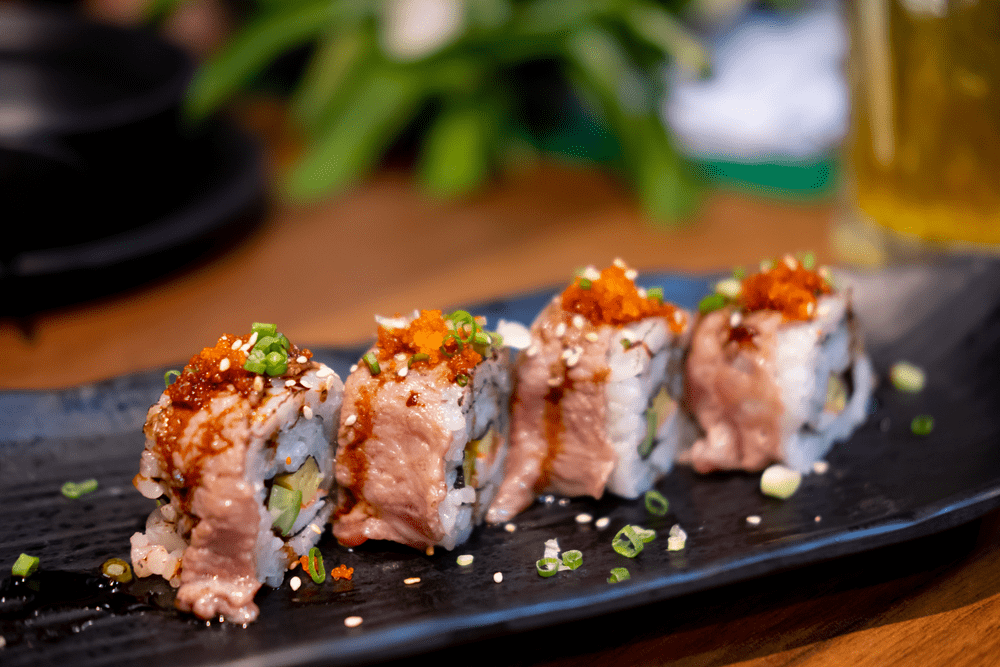
You can fill beef sushi rolls with steak, cold roast, or cooked beef. You can use either the maki or uramaki method to roll up the beef, also adding vegetables such as carrot or green beans in the center.
2. Chicken Mayo Roll
View in gallery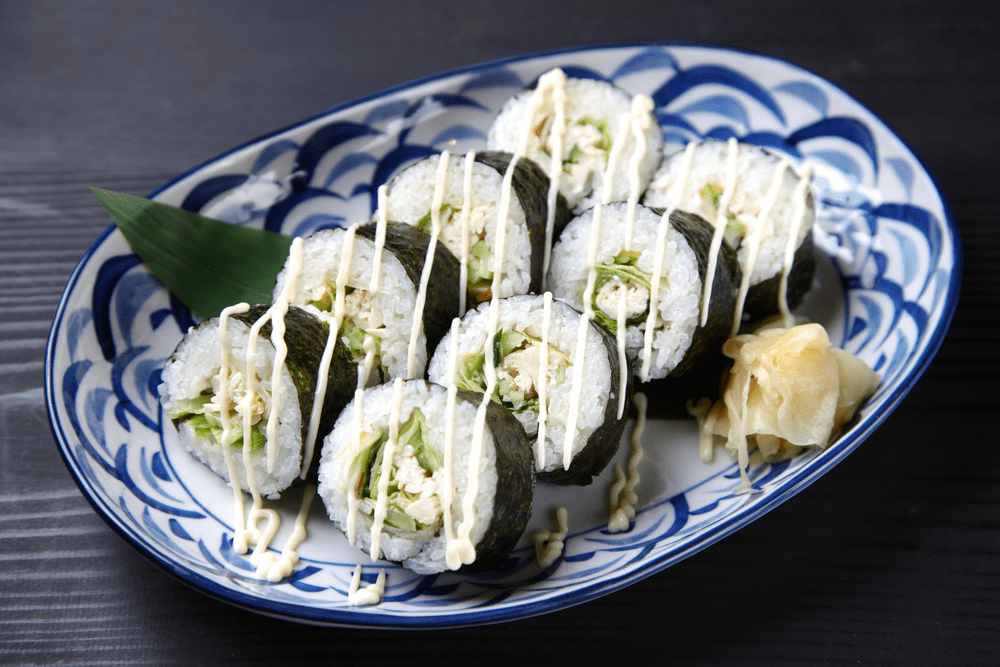
Chicken goes extremely well in sushi, and it also pairs nicely with the Japanese kewpie mayonnaise. Wrap the chicken and thin slices of avocado up in nori, then in sushi rice. You can top it with the kewpie mayonnaise and sprinkle with sesame seeds to garnish.
3. Teriyaki Chicken Roll
View in gallery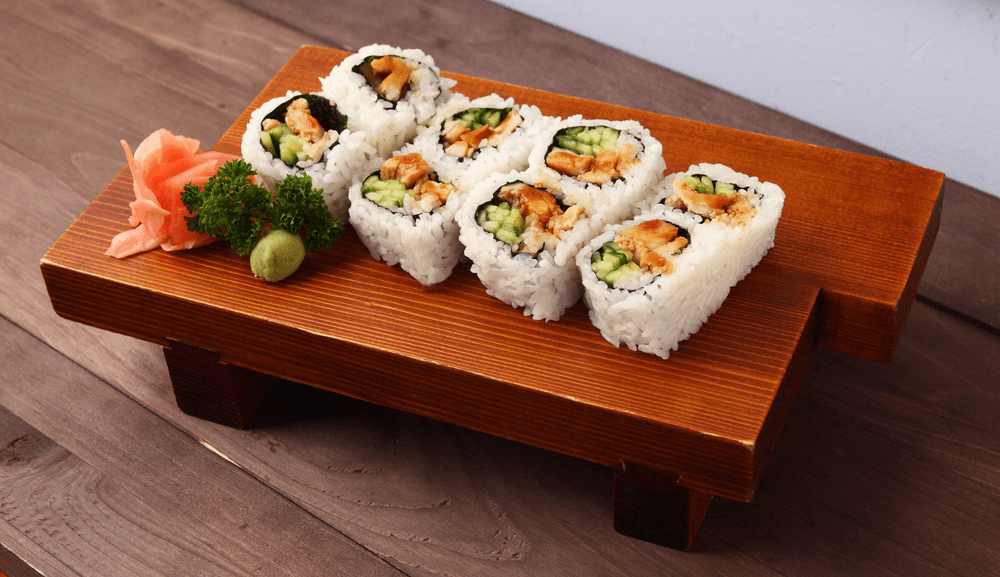
Teriyaki chicken is a popular dish in Japan, so why not include it in sushi. A mixture of teriyaki chicken and crunchy cucumber goes well together and makes an ideal filling for non-fish lovers.
A soft avocado topping will also give an added flavor and texture to the roll, but that choice is up to you.
4. Pulled Pork Roll
View in gallery
Pulled pork makes an excellent ingredient for meat sushi because of how easy it is to sculpt. Slaw compliments pork perfectly, and to make it taste slightly more like traditional sushi, you can use kewpie mayonnaise for the base.
Korean pulled pork, bbq pulled pork, or simply plain pulled pork, the choices for your sushi fillings are endless.
Final Thoughts on the Different Types of Sushi
Sushi is not only popular in Japanese culture, but they’ve also won over the hearts of food lovers everywhere.
Whether you prefer sushi using meats instead of raw fish or diving all in and sampling every roll on the menu, there is a type of sushi for everyone.
As we come to a close, we’d love to know your opinions on sushi. Are you on team raw fish, or do you prefer to play it safe with different meat variants? Is there any sushi you think should have made it onto the most popular types of sushi rolls?
Let us know down in the comments!




